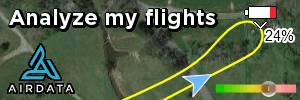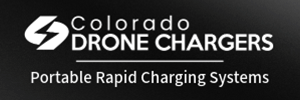You are using an out of date browser. It may not display this or other websites correctly.
You should upgrade or use an alternative browser.
You should upgrade or use an alternative browser.
Discharge All 3 Air 3S Batteries Before Airline Trip?
- Thread starter Steelgtr
- Start date
You don't need to discharge your batteries before taking them on a plane.How can I discharge my 3 Air 3S batteries to safe level before air travel soon without having to use the drone to do it? I have the fly more combo with the charging caddy.
No-one at the airport will care or want to check the battery charge levels.
No airline or air safety agency requires that.
It's just one of the myths that circulate in drone forums.
Another myth is that you need to pack them in LiPo bags.
Check your airline's website and look for a section regarding batteries or dangerous goods to see their requirements.
The important one will be that batteries go in your carry on luggage, not in checked luggage.
Thanks, I never had an issue before but it's been 3 years. ThanksYou don't need to discharge your batteries before taking them on a plane.
No-one at the airport will care or want to check the battery charge levels.
No airline or air safety agency requires that.
It's just one of the myths that circulate in drone forums.
Another myth is that you need to pack them in LiPo bags.
Check your airline's website and look for a section regarding batteries or dangerous goods to see their requirements.
The important one will be that batteries go in your carry on luggage, not in checked luggage.
I just flew 2 months ago and I had to declare that I didn't have any Li-Ion batteries in my luggage.
I think that was the only thing they mentioned about batteries.
I think that was the only thing they mentioned about batteries.
Mrktn
Well-Known Member
I’ve always carried mine fully charged (3 batteries in a fly more combo).
Have always kept one of the batteries in the drone and the other two in the charging hub.
Last year I was told by airport security to take the battery out of the drone and put it in the charging hub with the other two for a Jet2 flight from Larnaca (Cyprus) to London Stansted but they didn’t care about the charge status of the batteries.
Hope this helps
Have always kept one of the batteries in the drone and the other two in the charging hub.
Last year I was told by airport security to take the battery out of the drone and put it in the charging hub with the other two for a Jet2 flight from Larnaca (Cyprus) to London Stansted but they didn’t care about the charge status of the batteries.
Hope this helps
JimSteadman
Well-Known Member
I have repeatedly traveled domestically and internationally with my drone (with one battery in the drone and the other two in the charging hub) and never had a problem. The batteries (and the drone itself), if it has a battery in it) must be in your carry-on luggage. But aside from that, relax.
Mrktn
Well-Known Member
I have been able to keep the battery in the drone through security on all flights until last year but for some reason they were adamant that I remove the battery from the drone before boardingI have repeatedly traveled domestically and internationally with my drone (with one battery in the drone and the other two in the charging hub) and never had a problem. The batteries (and the drone itself), if it has a battery in it) must be in your carry-on luggage. But aside from that, relax.
Reginald E Johnson
Well-Known Member
I don’t discharge my Batteries and I have taken them all over the World! But I do keep my spare battery in the Case and restrains on my Drone and that’s it!You don't need to discharge your batteries before taking them on a plane.
No-one at the airport will care or want to check the battery charge levels.
No airline or air safety agency requires that.
It's just one of the myths that circulate in drone forums.
Another myth is that you need to pack them in LiPo bags.
Check your airline's website and look for a section regarding batteries or dangerous goods to see their requirements.
The important one will be that batteries go in your carry on luggage, not in checked luggage.
Correct, no Li-ion batteries in checked luggage.I just flew 2 months ago and I had to declare that I didn't have any Li-Ion batteries in my luggage.
I think that was the only thing they mentioned about batteries.
I've flown several times per year for the last few years, always with my drone and batteries in my carry-on backpack. About 25% of the time I get the hands-on security screening of the bag, but no one has ever taken issue with the batteries.
tvdwouw
Well-Known Member
I assume you mean that you had to declare you had no Lipos in your checked luggage? They are surely allowed in your cabin luggage.I just flew 2 months ago and I had to declare that I didn't have any Li-Ion batteries in my luggage.
I think that was the only thing they mentioned about batteries.
It's entirely possible. I was running on just a couple hours of sleep.I assume you mean that you had to declare you had no Lipos in your checked luggage? They are surely allowed in your cabin luggage.
I don't recall seeing a sign on my return flight but I had a battery backup CPAP in my checked luggage. I don't know what the battery is in that thing but it's supposed to be able to power it for quite a few hours.
Droning on and on...
Well-Known Member
Not recommending any practice or protocol here. Just informing.
The danger with lithium ion batteries is the rate at which they can release energy. Formally this is Power, watts. A shorted cell can dump it's entire stored energy in less than a minute. This is a lot like gasoline. Rapid release of energy is what an explosion is.
Compare gasoline to kerosene. Squirt BBQ lighter fluid all over some briquettes and put a match to it, and is gradually lights and spreads. Try that with the same amount of gasoline.
So the biggest risk with lithium ion batteries is when they're charged. Depleted batteries don't explode. They don't catch fire. They get warm, even hot but not catastrophically so, if shorted.
We don't have the option to deplete our batteries to the maximum degree just short of damaging them. The BMS gets in the way. Also, depleting them to a safe but undamaged level requires technical sophistication beyond most users. So we don't even talk about it.
All that said, the safest way to travel with your batteries is to run them down to absolute forced-on-the-ground landing while holding full throttle stick. Then, 5-10 hours after traveling, charge them so they don't stay in this depleted state for long. It's like shipping and empty gas can with fumes, vs. a full can.
That's the safest. It is also utterly impractical.
The danger with lithium ion batteries is the rate at which they can release energy. Formally this is Power, watts. A shorted cell can dump it's entire stored energy in less than a minute. This is a lot like gasoline. Rapid release of energy is what an explosion is.
Compare gasoline to kerosene. Squirt BBQ lighter fluid all over some briquettes and put a match to it, and is gradually lights and spreads. Try that with the same amount of gasoline.
So the biggest risk with lithium ion batteries is when they're charged. Depleted batteries don't explode. They don't catch fire. They get warm, even hot but not catastrophically so, if shorted.
We don't have the option to deplete our batteries to the maximum degree just short of damaging them. The BMS gets in the way. Also, depleting them to a safe but undamaged level requires technical sophistication beyond most users. So we don't even talk about it.
All that said, the safest way to travel with your batteries is to run them down to absolute forced-on-the-ground landing while holding full throttle stick. Then, 5-10 hours after traveling, charge them so they don't stay in this depleted state for long. It's like shipping and empty gas can with fumes, vs. a full can.
That's the safest. It is also utterly impractical.
Not really. A can of fumes can explode. A can of gasoline is very unlikely to explode.It's like shipping and empty gas can with fumes, vs. a full can.
There's actually a golden ratio for gasoline to explode. It will explode between 6:1 and 20:1 but maximum efficiency is around 14.5:1Not really. A can of fumes can explode. A can of gasoline is very unlikely to explode.
Funny story. My grandpa used to flick his cigarettes into an open bucket of gas that he would use to wash car parts. The butts would just go out like they were dropped in water. Until that one day when it didn't.
FWIW, he died of cancer at 56 years old. I'm sure the smoking was the biggest part but washing parts in gasoline didn't help.
Droning on and on...
Well-Known Member
Not really. A can of fumes can explode. A can of gasoline is very unlikely to explode.
Good point.
I don't think there is that setting in the app?Remove the batteries from the charging hub and drone, then set the auto-discharge time to the shortest setting (1-2 days) in the DJI Fly app. They will self-discharge to a safe level for air travel.
Similar threads
- Replies
- 18
- Views
- 2K
- Replies
- 4
- Views
- 3K
DJI Drone Deals
New Threads
-
-
Air 3s Valley Of Rocks, Lynton, North Devon at sunset. 16/12/25
- Started by Jeremy Clark
- Replies: 0
-
DJI Geo Fencing Sneaking Back In Via Firmware "Update". Beware!
- Started by Conservative Nihilist
- Replies: 2
-
-









